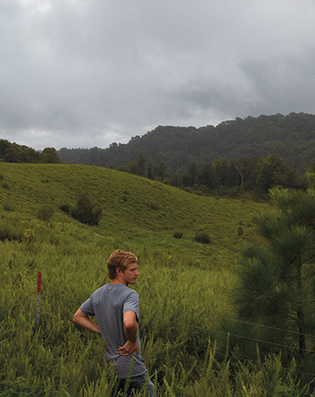 loading
loading
Where They Are NowYes, coal country has a futureA ninth-generation Appalachian reclaims the mountains.  Courtesy Nathan Hall ’17MEM/MBAIn central Appalachia, Nathan Hall ’17MEM/MBA is working to turn demolished mountaintops into farms that provide jobs. View full imageNathan Hall ’17MEM/MBA is a farmer of mountains that have been turned inside out. As president of the nonprofit Reclaim Appalachia, based in Charleston, West Virginia, he uses agriculture to restore both mountaintop lands and rural economies left impoverished by the waning of the coal industry. This mission is personal: his great-great-great-great-great-great-grandparents settled in the region around the time of the American Revolution, and his family has lived there ever since. Y: What is Appalachia? H: There are a few different ways to take that word, but I’m concerned with one specific part of Appalachia, central Appalachia, which is what typically comes to mind when people think of the region. It’s southern West Virginia, eastern Kentucky, northeast Tennessee—all of the steep hills and hollers where the cultural stereotypes of hillbilly come from—the coal-producing region. That’s where I’m from, that’s where my family has been since the late 1700s, and it’s a part of the United States that has some of the highest rates of poverty, some of the worst health indicators. Y: What kinds of misconceptions did people hold about the region when you got to Yale? H: People often assumed it was racist, and conservative in that backwards kind of way. When the election happened, it made everything a hundred times worse. It reinforced everyone’s preconceived notions: probably just a racist, xenophobic region. That’s something I’ve had to continue to dispel. The people are actually very nice! Y: What are you reclaiming? H: The primary focus is these very large landscapes where tops of mountains were basically blown off to access the layers of coal underneath, and then the overburden [the unused material] was redistributed as the new surface. We’re trying to develop profitable and sustainable projects on these landscapes that restore ecological health and provide jobs that, if not as high-paying as coal mining jobs, are based on markets that aren’t going to disappear. Y: What markets are those? H: We’re first using rotational grazing of livestock—goats, hogs, chickens—to bring back nitrogen and organic matter while providing meat and eggs. Following that, we’ll transition into mixed orchards with high-value herbs [such as lavender] and different kinds of berries and fruits. Grapes also do fairly well. The final piece is to have as much value-add in the region as possible: processing centers, the production of wine, that sort of thing. Y: You emphasize that you’re a ninth-generation Appalachian. H: It’s fairly rare in the US to know that your ancestors have been in a place going back to the Revolutionary War. It signifies a deep ancestral connection to place. Y: Does that rootedness inform your approach? H: Probably? I’d like to think it informs a long-term view of the way we address these landscapes. Of course, we want to generate profitable returns, but in the back of my mind I’m always wondering whether the land would be better or worse for what I’ve done if I just disappeared. Y: If this grew to what you imagine it could, how would that economy stand relative to the coal economy? H: Nothing will replace the coal industry. But we’re talking about an industry that, even if there hadn’t been a market downturn, would’ve still been finite. And coal was always boom and bust. I think that’s important context. With only the agricultural work, not including processing, we can maybe employ a tenth of the people at roughly a third to half the pay, but we’re looking at this as one piece in the overall puzzle. Hopefully another piece will be a drastically improved educational system that actually equips people for a twenty-first-century, knowledge-based economy.
The comment period has expired.
|
|